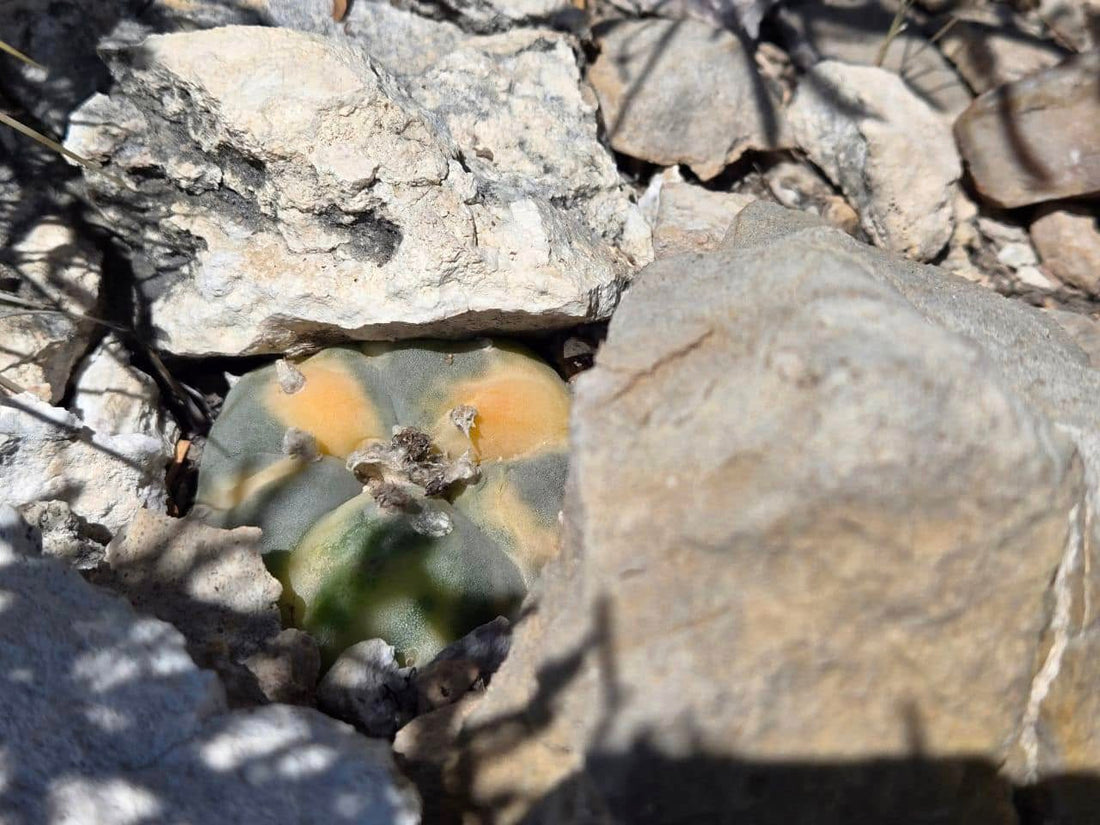
Variegated Lophophora in Nature
Share
This Lophophora williamsii from Trans-Pecos, Texas, is a variegated specimen discovered tucked away among limestone rocks at an elevation of 4,078 feet (1,243 meters) on a south-facing slope. It only gets direct sunlight in the morning and spends the rest of the day in the shade. This particular plant was hidden beneath Echinocereus stramineus and Jatropha dioica, and it was found near other species such as Pelecyphora tuberculosa (formerly Escobaria), Agave lechuguilla, and Opuntia phaeacantha.
Biotope:
The surrounding area is typical of a semi-desert environment, featuring rocky terrain and sparse vegetation that are well-adapted to arid conditions.
Variegation in Lophophora williamsii:
Variegation in this genus is relatively uncommon and is characterized by patches on the plant where chlorophyll is absent, resulting in colors like yellow, orange, or pink instead of green. This usually happens because of genetic mutations that interfere with normal chlorophyll production. These mutations can either be passed down from parent plants or occur spontaneously. In some instances, the mutation affects genes that control chloroplast development—the cell structures where photosynthesis takes place—while in others, it may result from an imbalance in the synthesis and breakdown of proteins within the chloroplasts.
In cacti, including those of the Lophophora genus, variegation can be seen in several forms:
- Chimeric variegation: Caused by mutations in some cells of the meristem (the growth zone), leading to unstable, uneven patterns.
- Genetic pattern variegation: Arises from mutations affecting all the tissues uniformly, resulting in consistent and stable patterns.
- Reflective or blister variegation: Occurs when variations in the structure of the epidermal cells cause differences in light reflection, creating a distinct visual effect.
Because variegated plants have reduced chlorophyll, they are generally more delicate and less efficient at photosynthesis compared to their entirely green counterparts. This reduced efficiency makes them rarer in nature. Nevertheless, in harsh environments like the Trans-Pecos, they can survive if they find microhabitats that offer some protection—such as areas with partial shade, nutrient-rich soils, or other conditions that help offset their limitations.
Cultivation and Occurrence:
In cultivation, variegation can sometimes be more readily induced by hybridizing plants from different regions or species. Even plants that are genetically pure may occasionally develop variegation due to spontaneous mutations, although such events are less common in the wild.
Impact on Alkaloid Production:
The genetic variegation in Lophophora williamsii also affects its chemical makeup, particularly the production of alkaloids like mescaline. The lack of chlorophyll in the variegated areas means that the plant’s photosynthesis—and thus its energy and nutrient production—is compromised. Since alkaloids are synthesized using these resources and serve as a defense mechanism against stresses like intense sunlight and drought, a reduction in photosynthesis leads to lower alkaloid levels. While some slightly variegated individuals might still produce adequate amounts, more pronounced variegation typically results in a significant decline in alkaloid production. Additionally, variegation may hinder the plant's ability to absorb key nutrients (such as nitrogen, phosphorus, and potassium), which are essential for producing these secondary metabolites.
Conclusion:
In essence, variegation in Lophophora williamsii results in a marked decrease in alkaloid production. This reduction is primarily due to the diminished presence of chlorophyll, which leads to lower photosynthetic activity and reduced uptake of vital nutrients. Consequently, the plant's ability to synthesize the compounds necessary for defense against environmental stresses and predators is limited. Despite these challenges, variegated plants can persist in extreme settings like the Trans-Pecos, thanks to microhabitats that provide slightly more favorable conditions.
Photocredit: Brian Penick
